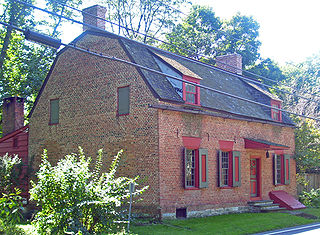
Claverack is a town in Columbia County, New York, United States. The population was 6,021 at the 2010 census. The town name is a corruption for the Dutch word “Klaverakker” for "Clover Fields" or "Clover Reach". In 1705, the first discovery of a mastodon tooth occurred here.

Jan Van Hoesen House is an early-18th-century house in New York State. Northeast on NY 66 of Hudson towards Chatham, just east of Claverack Creek, stands a vacant medieval-looking brick structure over the Dutch Acres Mobile Home Park. Like the Columbia County Historical Society's Luykas Van Alen House in Kinderhook, the steeply-pitched roof, parapet-gabled house is a rare surviving example of a type of rural house characteristic of the upper Hudson Valley in the first half of the 18th century. Van Hoesen House is located on Route 66, north of the City of Hudson.

New York's historic Putnam County Courthouse is located on Gleneida Avenue across from the eastern terminus of NY 301 in downtown Carmel, the county seat, overlooking Lake Gleneida. First built in 1814, two years after the county itself was established, it is the second-oldest county courthouse still in use in the state after Fulton County's.

The U.S. Post Office in Hudson, New York, United States, is located on Union Street at the corner of South Fourth Street, just across from the Columbia County courthouse. It serves the ZIP Code 12534, which covers the city of Hudson and surrounding areas of the Town of Greenport.
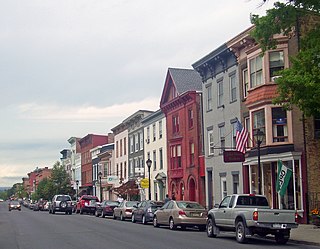
The Hudson Historic District includes most of downtown Hudson, New York, United States, once called "one of the richest dictionaries of architectural history in New York State". It is a 139-acre (56 ha) area stretching from the city's waterfront on the east bank of the Hudson River to almost its eastern boundary, with a core area of 45 blocks. It has 756 contributing properties, most of which date from the city's founding in 1785 to the mid-1930s. In 1985 it was listed on the National Register of Historic Places.
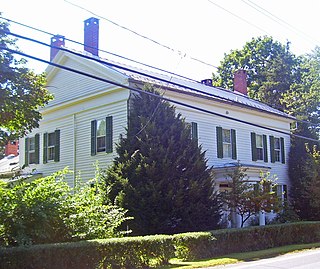
The Stephen Hogeboom House is located on NY 23B in Claverack, New York, United States. It is a frame Georgian-style house built in the late 18th century.

The Cornelius S. Muller House is located along NY 23B in Claverack, New York, United States. It is a pre-Revolutionary brick house in a Dutch Colonial style with some English influences.
The People of the State of New York v. Harry Croswell, commonly known and cited as People v. Croswell, is an important case in the evolution of United States defamation law. It was a criminal libel case brought against a Federalist journalist named Harry Croswell for his statements about a number of public officials, including then-President Thomas Jefferson.

The Claverack Free Library is located on NY 23B near the center of the hamlet of Claverack-Red Mills, New York, United States. It is a small Colonial Revival building constructed in the early 1930s from a design by local architect Lucius Moore.

The Reformed Dutch Church of Claverack is located on New York State Route 9H at the north end of the hamlet of Claverack, New York, United States. It is a brick church built in the mid-18th century and renovated and expanded twice in the 19th, reaching its present form in 1879. The congregation was founded in 1716.
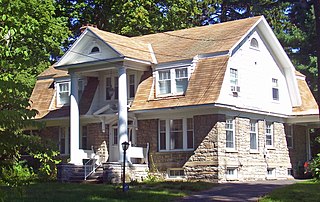
The George Felpel House is located on NY 9H in Claverack-Red Mills, New York, United States. It is a stone Colonial Revival and Dutch Colonial Revival house built in the 1920s.

The Harmon Miller House, also known as Brookbound, is located on NY 23/9H on the south edge of Claverack, New York, United States. It is a wooden house on a medium-sized farm built in the 1870s.
The Jacob P. Mesick House is located on Van Wyck Lane in Claverack-Red Mills, New York, United States. It is a wooden house in the Greek Revival architectural style built in the mid-19th century.

The Van Rensselaer Lower Manor is located along the NY 23 state highway on the east side of Claverack, New York, United States. It is a combination of two 18th-century houses, one stone and the other frame, later connected with a hyphen and then combined into one building and sided in wood. One local historian called the result a "growth" that no longer had any architectural merit. It retains much of its original interior layout, finishes and fenestration.
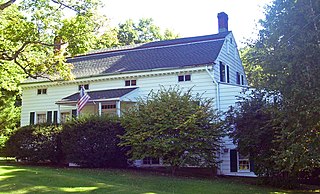
The Stephen Miller House, also known as the Van Wyck-Miller House, is located along the NY 23 state highway in Claverack, New York, United States. It is a wooden farmhouse dating from the late 18th century.

The Dr. Abram Jordan House is located along the NY 23 state highway in Claverack-Red Mills, New York, United States. It is a brick Federal style house, with some Greek Revival decorative touches, built in the 1820s as a wedding present from a local landowner to his daughter and son-in-law.

The Stephen Storm House is located on the NY 217 state highway just east of Claverack, New York, United States. It is a Federal style brick house built in the early 19th century.

Jacob Rutsen Van Rensselaer House and Mill Complex is a historic home and mill complex consisting of 14 interrelated buildings and located at Claverack in Columbia County, New York.
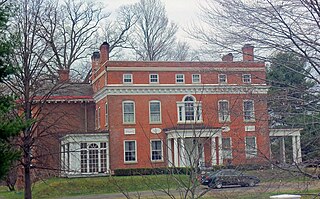
Maizefield, often locally called Maizeland, is a historic house on West Market Street in the village of Red Hook, New York, United States. It is a large plain brick building, in the Federal style, with clear English Georgian influences, built around the end of the 18th century. In 1973 it was listed on the National Register of Historic Places.

The Hendrick Martin House is located on Willowbrook Lane in the town of Red Hook, New York, United States, just north of the eponymous village. It is a stone house built in two phases in the mid- and late 18th century. In 2007 it was listed on the National Register of Historic Places.






















